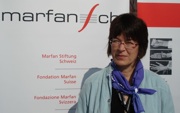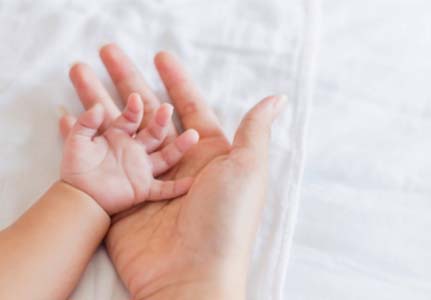Marfan syndrome: The silent disease
Véronique Vrinds was not just taller than her friends at school; she was also a bit more awkward and much more prone to sprains.
While growing up, she developed back pain, her thorax was larger than normal and she tired easily. “But my mother had the same health problems and so we all blamed our height and learned to live with that,” says Véronique Vrinds, a mother of two, who lives in Belgium.
 Véronique Vrinds was not just taller than her friends at school; she was also a bit more awkward and much more prone to sprains. While growing up, she developed back pain, her thorax was larger than normal and she tired easily. “But my mother had the same health problems and so we all blamed our height and learned to live with that,” says Véronique Vrinds, a mother of two, who lives in Belgium.
Véronique Vrinds was not just taller than her friends at school; she was also a bit more awkward and much more prone to sprains. While growing up, she developed back pain, her thorax was larger than normal and she tired easily. “But my mother had the same health problems and so we all blamed our height and learned to live with that,” says Véronique Vrinds, a mother of two, who lives in Belgium.
In June 2001, she brought her son Joe, aged 3 at the time, to a cardiologist, who discovered an enlarged aorta, one of the symptoms of Marfan Syndrome. “This cardiologist urged me to see a geneticist, because Marfan can be hereditary, but I couldn’t believe that I had a rare disease. My life had been a near-normal one. Maybe I was just too scared of the reality of this news” confides Véronique. A year later, the Marfan Syndrome diagnosis was confirmed for her, her son Joe and her mother.
Marfan syndrome is a disorder of the connective tissue. Connective tissue holds all the parts of the body together and helps control how the body grows. Because connective tissue is found throughout the body, features of Marfan syndrome can occur in many different parts of the body. Marfan syndrome features are most often found in the heart, blood vessels, bones, joints, and eyes. Sometimes the lungs and skin are also affected. About 1 in 5,000 people have Marfan syndrome. Marfan syndrome is often hereditary, but approximately 25-30% of affected people are the first in their family to have the disorder. Thousands do not even know that they are affected.
In 2004, feeling extremely tired, Véronique Vrinds visited another cardiologist who discovered that her aorta was enlarged to 55 millimetres (the critical size being 50 mm). She had a heart operation within a month. “This operation was a wake-up call. I realised that I had a serious disease that could not be put on the back seat. So I started looking for people who had Marfan disease and had been operated on. I ended up on the forum of the Belgium Marfan Syndrome Association,” recalls Véronique. The Belgium association was created in 1999 by Yvonne Jousten after her son was diagnosed with Marfan Syndrome. Véronique went to a meeting and two years later, she became the association’s secretary. “I had to help people suffering from Marfan Syndrome like me, like my son, like my mother. But I also know that I am one of the lucky ones to be diagnosed in time. Many people just don’t know they have Marfan and one of the association’s objectives is to raise awareness about this rare disease.”
 Maelle Pérez is the social counsellor working with the Swiss Marfan Foundation. She does not have the syndrome but she knew about it even before working with the foundation. “When I was 18 years old, I had some heart problems. As I was tall and very thin, the doctors mentioned Marfan Syndrome for a while before discarding it,” remembers Maelle. The Marfan Swiss Foundation was founded in 1987 by Sylvia Weiss and Gerhard Zumstein, after they lost their 15 year old son following a dissection of the aorta. Despite his obvious symptoms and the many problems he suffered in daily life, he was diagnosed with Marfan Syndrome only a few months before his death. At that time, in Switzerland nothing existed for Marfan Syndrome patients and the disease wasn’t known at all. “Their tragic loss was the motivation behind Sylvia Weiss and Gerhard Zumstein wanting to help prevent other people suffering the same ordeal. In the beginning they made such an impact that the local media commented that ‘Marfan-hysteria’ had broken out in their region,” explains Maelle Pérez. “From the beginning, the aim of the foundation was to team up affected people and their relatives with scientists, doctors and specialists in order to help and support affected people. This is reflected in the composition of the Swiss Marfan Foundation’s Board on which there are currently affected people, four doctors, a communications specialist and a lawyer. The challenge was, and still is, to provide specialist medical care and treatment, as well as good support and counselling, for the relatively small number of people (approximately 750) affected by this complex disorder in Switzerland.”
Maelle Pérez is the social counsellor working with the Swiss Marfan Foundation. She does not have the syndrome but she knew about it even before working with the foundation. “When I was 18 years old, I had some heart problems. As I was tall and very thin, the doctors mentioned Marfan Syndrome for a while before discarding it,” remembers Maelle. The Marfan Swiss Foundation was founded in 1987 by Sylvia Weiss and Gerhard Zumstein, after they lost their 15 year old son following a dissection of the aorta. Despite his obvious symptoms and the many problems he suffered in daily life, he was diagnosed with Marfan Syndrome only a few months before his death. At that time, in Switzerland nothing existed for Marfan Syndrome patients and the disease wasn’t known at all. “Their tragic loss was the motivation behind Sylvia Weiss and Gerhard Zumstein wanting to help prevent other people suffering the same ordeal. In the beginning they made such an impact that the local media commented that ‘Marfan-hysteria’ had broken out in their region,” explains Maelle Pérez. “From the beginning, the aim of the foundation was to team up affected people and their relatives with scientists, doctors and specialists in order to help and support affected people. This is reflected in the composition of the Swiss Marfan Foundation’s Board on which there are currently affected people, four doctors, a communications specialist and a lawyer. The challenge was, and still is, to provide specialist medical care and treatment, as well as good support and counselling, for the relatively small number of people (approximately 750) affected by this complex disorder in Switzerland.”
In 2007, the Swiss Marfan Foundation celebrated its 20 years of existence and on 1st June 2009, the Belgium Marfan association held its 10-year anniversary. For the two organisations, the motto remains the same: helping patients and giving a voice to this silent and yet terrible rare disease.
This article was first published in the July 2009 issue of the EURORDIS newsletter
Author: Nathacha Appanah
Photo credits: Véronique Vrinds & logo © L’ Association Belge du Syndrome de Marfan (ABSM) ; Maelle Pérez © Marfan Stiftung Schweiz

